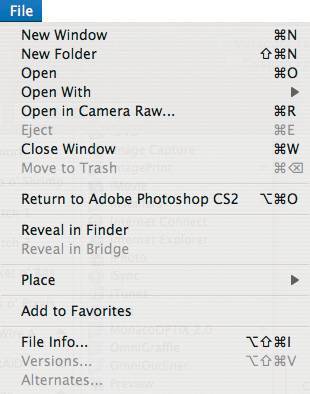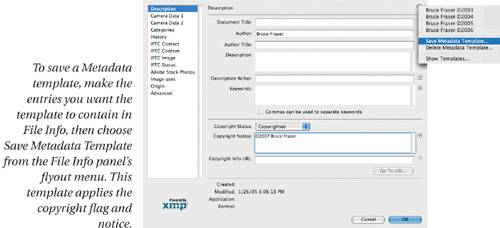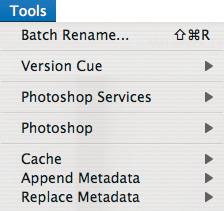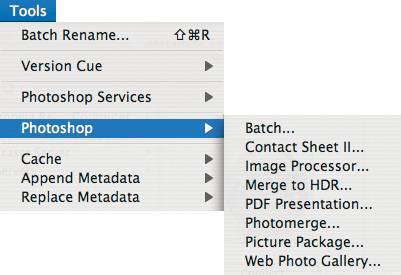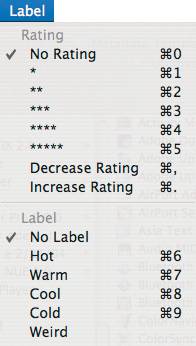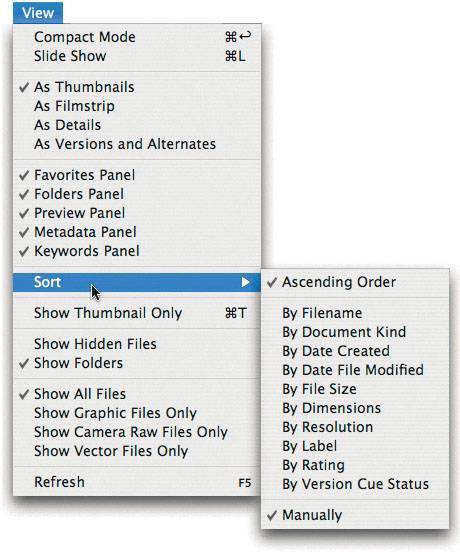Bridge Menu Commands
| Bridge serves not only Photoshop but the entire Creative Suite, so a good many of its menu commands aren't relevant to a digital raw workflow. Moreover, many of the menu commands offer relatively inefficient ways to accomplish tasks that can be performed more easily by other means, so we'll content ourselves with providing an overview of the menus, along with details about the commands we find particularly useful. Preferences and the Bridge MenuThe Bridge menu, which is found only in the Macintosh version of Bridge, contains only one important command: Preferences (press Command-K). You can also get to the Preferences dialog box with the Camera Raw menu (see "The Camera Raw Menu" earlier in this chapter). On Windows, this also lives on the Edit menu. Bridge's Preferences dialog box contains six different panels, each governing a different aspect of Bridge's behavior. General PreferencesThe controls in the General panel let you set the shade of gray for the background on which thumbnails are displayed, hide or show tooltips, and specify up to three additional lines of metadata that are displayed under the thumbnail along with the filename (see Figure 11-51). It also lets you specify items that always appear in the Favorites panel, and offers two control buttons, one of which reveals scripts in the Finder (Mac) or Explorer (Windows). Figure 11-51. Bridge Preferences, General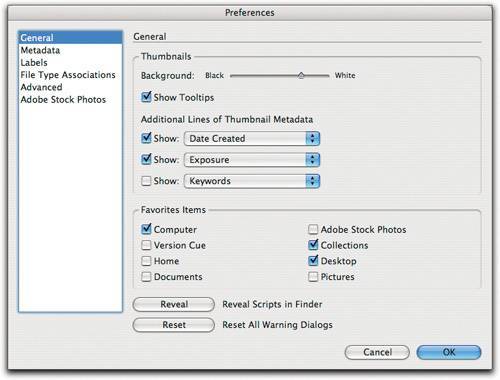 Metadata PreferencesThese options let you specify which metadata fields are displayed on the Metadata palette. If you don't have a GPS-enabled camera, for example, you may as well hide all the GPS fields. This panel also offers the option to hide fields that are empty for the selected image or images automatically (see Figure 11-52). Figure 11-52. Bridge Preferences, Metadata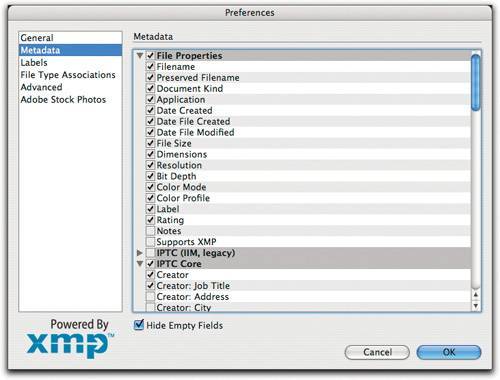 Labels PreferencesThese options let you associate text labels with the label colors (you can't change the colors) to something more useful than the color names (see Figure 11-53). The label text is searchable in Bridge, and can be displayed both in the Metadata palette and as an additional line of metadata accompanying the thumbnails if you choose that option in the General Preferences tab. If you change the label text in Preferences, images that have previously had labels applied lose the label colorit turns whitebut the label text remains part of the image's metadata. Figure 11-53. Bridge Preferences, Labels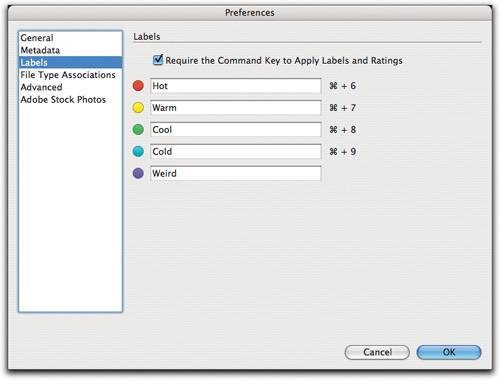 File Type Association PreferencesThese options let you specify the default application for opening files from Bridge. They apply only to the behavior you get when opening files from Bridge, and have no effect on OS-level behavior (see Figure 11-54). Figure 11-54. Bridge Preferences, File Type Associations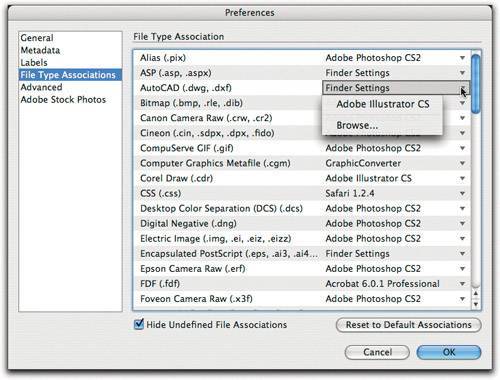 Advanced PreferencesThis panel contains several unrelated but nevertheless important items (see Figure 11-55). The Miscellaneous preferences are largely self-explanatory, with the exception of "Double-click edits Camera Raw settings in Bridge." When this preference is turned off (which it is by default), double-clicking a raw's thumbnail opens it in Camera Raw hosted by Photoshop. When it's checked, doing the same thing opens the raw image in Camera Raw hosted by Bridge. This preference works as advertised, but has a non-obvious impact on some other file-opening keyboard shortcuts (see "File Info and the File Menu," on the next page). The other important setting in this panel is the choice of whether to use centralized or distributed cache files. Figure 11-55. Bridge Preferences, Advanced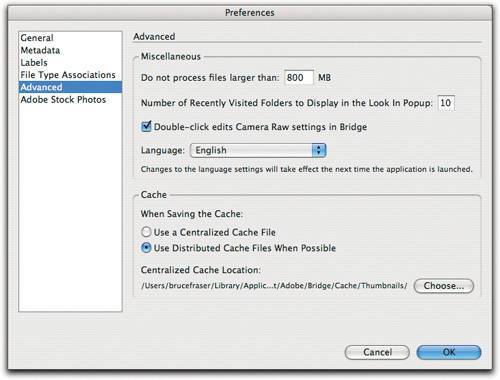 Bridge's cache holds the image thumbnails and previews, custom sort order, andfor file types that can't store metadata either in the file itself or in a sidecar .xmp filelabel and rating information. For raw files, only the thumbnails, previews, and custom sort order are stored uniquely in the Bridge cache, but since the thumbnails and previews take some time to generate, they're pretty important. The only advantage offered by using a centralized cache is simplicityyou know where all your cache files are. The significant disadvantages of the centralized cache are:
Using a distributed cache avoids both problems. The cache files are written directly into the folder to which they pertain, and travel with the folder even when it's renamed or moved. But note that if Bridge for some reason can't write a distributed cache (the volume may be read-only, or mounted on a server) it writes to the central cache instead. The only real downside to using distributed caches is that every folder that Bridge has opened ends up with two files named Adobe Bridge Cache.bc and Adobe Bridge Cache.bct. By default, Bridge hides these files, but the Macintosh Finder and Windows Explorer do not. If this makes you squirrely, by all means use the centralized cache; otherwise it's well worth suffering the small inconvenience to obtain the benefits of distributed caching. (And besides, it's often useful to be able to see the cache files so that you can check that they're present and up-to-date.) File Info and the File MenuThe bulk of the commands on the File menu let you do things that are better accomplished via keyboard shortcutsopening images, creating new windows, and so on (see Figure 11-56). Figure 11-56. Bridge File menu In the case of raw images, the subtle difference between "Open" (Command-O) and "Open in Camera Raw" (Command-R) is that the former opens the raw image or images in Camera Raw hosted by Photoshop, while the latter opens the raw image or images in Camera Raw hosted by Bridge. There are several easier ways to open images than choosing the menu commands, including the aforementioned keyboard shortcuts, and the ones listed in Table 11-1.
Most of the other commands are self-explanatory. However, the File Info command, which opens the File Info panel, deserves a closer look (see Figure 11-57). Figure 11-57. Bridge File Info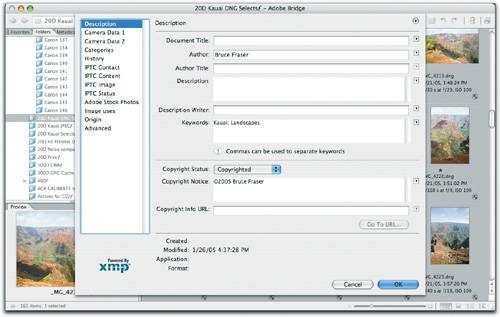 The first thing you'll notice when you open File Info in Bridge is that it's a modal panel (not a movable modal dialog box) that helpfully covers all the images. We find this behavior a bit south of being ideal! While Bridge allows you to open File Info when multiple images are selected (the old File Browser did not), it's a relatively inefficient way to apply keywords and other metadata when compared to the Metadata and Keywords palettes. Nevertheless, we use it in three ways:
Select, Find, and Edit with the Edit MenuThe Edit menu hosts Bridge's Preferences command on Windows. It also hosts the usual Copy, Paste, Cut, and Duplicate commands, as well as the Rotate commands (whose functionality is replicated by Bridge's Rotate buttons). The important commands for the raw workflow are the various Select commands, the Find command, and the Apply Camera Raw Settings commands (see Figure 11-59). Figure 11-59. The Edit menu Selection commandsThe Select commands offer quick ways to manipulate selections. Select All (press Command-A), Deselect All (press Command-Shift-A) and Invert Selection (press Command-Shift-I) do exactly what they sayInvert Selection deselects the files that were selected and selects those that weren't. The two remaining commands, Select Labeled and Select Unlabeled (press Command-Option-L and Command-Option-Shift-L, respectively), work in conjunction with Bridge's Label feature, which lets you apply one of five labels, or no label, to images. See "Labeling, Rating, and the Label Menu," later in this chapter. Find commandThe Find command lets you perform searches using up to 13 different search criteria (see Figure 11-60). Figure 11-60. The Find dialog box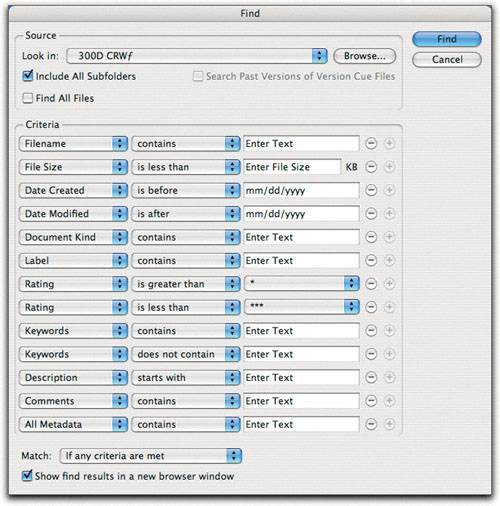 In addition to the criteria, the Find dialog box has the following important features.
Save As CollectionWhen you perform a search, you have the option to save the search criteria as a "collection." Unfortunately, it's slightly confusing that the option doesn't appear in the Find dialog box, but rather in the results window (see Figure 11-61). Figure 11-61. Save As Collection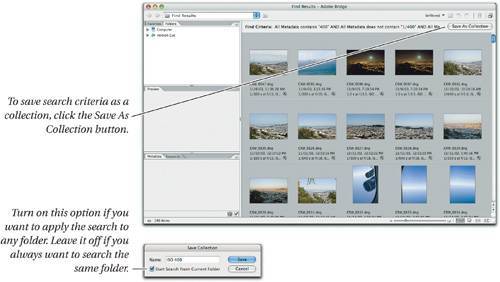 When you save a collection, you can save it as an "absolute" search or a "relative" search. Absolute searches always search the folder you specified in the Find dialog box's Look In popup menu when you performed the initial search that created the results; relative searches can be applied to any folder. Turning on the "Start Search From Current Folder" option in the Save Collection dialog box creates a relative search; leaving it turned off creates an absolute one. Collections are saved in User/Library/Application Support/Adobe/Bridge/Collections (Mac) or Documents and Settings\Username\Application Data\Adobe\Bridge\Collections (Windows). Apply Camera Raw SettingsThe Apply Camera Raw Settings submenu lets you apply Camera Raw Defaults or Previous Conversion (the last-used Camera Raw settings) to selected images (see Figure 11-62). It also lets you copy settings from an image and apply them to others by pasting, or clear existing settings from an image. Finally, it lets you apply any saved settings that you've saved in Camera Raw's Settings folder (see "Loading and Saving Settings" earlier in this chapter). Figure 11-62. Apply Camera Raw Settings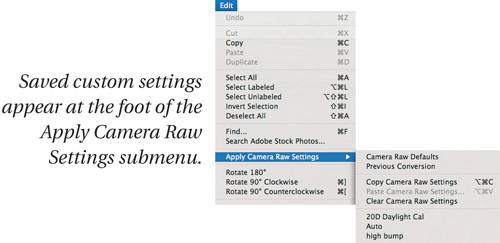 The difference between applying Camera Raw defaults and clearing Camera Raw settings is rather subtle. The effect on the image is identical in both cases, but Bridge offers a useful piece of feedback that shows whether or not an image has settings applied to it (see Figure 11-63). When you apply Camera Raw defaults, Bridge treats the image as having had settings applied; when you clear the settings, Bridge treats the image as having no settings applied. Figure 11-63. Apply Camera Raw Defaults and Clear Camera Raw Settings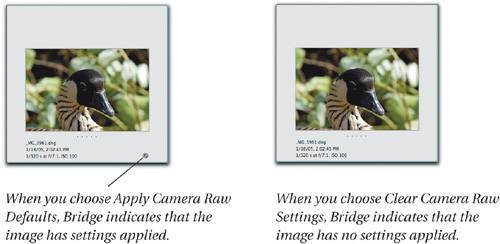 The Copy Camera Raw Settings command (Command-Option-C) copies all the Camera Raw settings from the selected image. When you choose Paste Camera Raw Settings (Command-Option-V), the dialog box shown in Figure 11-64 appears, giving you the opportunity to choose all the settings, any individual parameter, or everything in between, to apply to the image or images to which you're pasting the settings. Figure 11-64. Paste Camera Raw Settings Pasting Camera Raw Settings to multiple images offers an alternative to working directly in Camera Raw in filmstrip mode. Automation, the Cache, and the Tools MenuThe Tools menu provides access to several useful Photoshop-hosted automation features as well as Bridge's own Batch Rename feature, allows you to manipulate Bridge's cache files, and provides an alternative means of applying metadata templates if you don't want to use the Metadata palette menu (see Figure 11-65). Figure 11-65. The Tools menu Batch RenameBridge's Batch Rename feature looks nothing like Photoshop's, though it offers essentially the same functionality. The option to preserve the current filename in XMP metadata actually adds a custom metadata tag containing the filename. If you've already applied Camera Raw settings before renaming, you can skip this option because the Camera Raw settings metadata already contains the original filename, but if you're renaming otherwise-untouched raw files, and you want the original filename to be retrievable, it's a good idea to turn on this option. Tip: Undoing Renaming One of the useful things that the aforementioned "Preserve current filename in XMP Metadata" option allows is easy undoing of batch renaming. Simply choose Batch Rename, and specify Preserved Filename. Your files will get renamed to their original filenames. You can add up to 10 different sets of data for inclusion in the filename. Since Bridge is eminently JavaScriptable, you can expect to see a variety of useful image-ingestion scripts, possibly including some from Adobe, that will likely include more flexible metadata-based renaming features, but Bridge's Batch Rename at least provides baseline functionality out of the box. PhotoshopThe Photoshop submenu (see Figure 11-66) provides access to several useful Photoshop automation features. If you want to run any of these automations using images selected in Bridge as the source, you must launch them from Bridge's Tools menuif you try to launch them from Photoshop's Automate submenu (in the File menu), you'll find that Bridge is either grayed out or simply unavailable as the source. Figure 11-66. The Photoshop submenu To invoke any of the Automate features from Bridge, select the images you want processed through the automation, then choose that automation from the Photoshop submenu (in Bridge's Tools menu). Photoshop then goes to work, opening the images using the Camera Raw settings you've applied, or the camera-specific default settings if you haven't applied settings to the image, then processing them using the settings you've specified for the automation. You can continue to work in Bridge while Photoshop is processing the images. Labeling, Rating, and the Label MenuThe Label menu offers a not-very-efficient alternative to the keyboard shortcuts for applying labels or ratings to your images (see Figure 11-67). The only things you can do from this menu that you can't do with keyboard shortcuts are to remove a label, and to apply the fifth label, which by default is called Purple (though you can change its name in Bridge's Preferences; see "Labels Preferences," earlier in this chapter). Figure 11-67. The Label menu Labels and ratings are entirely separate (see Figure 11-68). Labels apply the selected label color to the image thumbnail's label area, and write the label text into the image's metadata (in the Label field under File Properties). Ratings apply zero to five stars to the image thumbnail's rating area, and write the rating (from one to five) into the image's metadata (in the Rating field under File Properties). Figure 11-68. Labels and ratings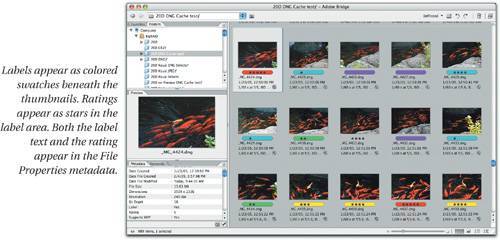 You can search images by label and by rating, and sort images by label or by rating. Last but not least, you can use the Unfiltered/Filtered menu (on Bridge's toolbar, not on the menu bar) to filter which images are displayed in the Bridge window based on label, on rating, or by doing first one, then the other, on both. Labels and ratings are simply arbitrary flags that you can apply to images. It's entirely up to you to decide what they mean. Bruce dislikes the Label feature because he doesn't want extraneous color in his field of view when he's looking at images, but he admits that that's a personal biaswhat's important is that you come up with a system that works for you. For some suggestions on how to use these features, see "Rating and Labeling," later in this chapter. Applying labels and ratingsBy far the easiest way to apply labels or ratings is to use the keyboard shortcuts (most of which also work in Camera Raw). To apply red, yellow, green, and blue labels, press Command-6 through Command-9, respectively. To apply the purple label, or to remove labels, you must use the menu commands. Inside Camera Raw, the purple label can be toggled using Command-Shift-0. To apply ratings, press Command-1 through Command-5 to apply that number of stars, and press Command-0 to remove ratings. Inside Camera Raw, the shortcut is command-~ (tilde) because Command-0 fits the image in the preview. You can also press Command-. (period) to increase the rating by one star or Command-, (comma) to reduce it. A slower but sometimes convenient alternative is to click and drag in the rating area of the thumbnaildragging to the right increases the rating, and dragging to the left reduces it. Last but not least, Command-' (apostrophe), toggles one star on or off. Bridge Display and the View MenuThe commands on the View menu offer a variety of controls over the way Bridge displays both its windows and their contents. In the former category, several of the commands replicate the functionality of the control buttons in Bridge's windowsCompact Mode, As Thumbnails, As Filmstrip, As Details, and As Versions and Alternates (the last is relevant for VersionCue users only). Others toggle the visibility of the individual panelsFavorites, Folders, Preview, Metadata, and Keywords (see Figure 11-69). Figure 11-69. The View menu SortYou can sort the contents of the Bridge window based on the file properties listed in the Sort submenu. Or, if you sort images into a custom order by dragging their thumbnails around, you'll see a checkmark next to the "Manually" itemchoosing this from the submenu has no effect unless you've previously sorted your images manually, in which case it switches to the last manual sort order you used. Show Thumbnail OnlyThe Show Thumbnail Only command suppresses the display of the filenames and any other optional metadata displayed under the thumbnails. Press Command-T to toggle the metadata display on and off. Note that despite its name, Show Thumbnail Only doesn't hide the other palettes. The easiest way to perform that trick is to click the Show/Hide panels button at the lower left of the window. Or, alternately, choose a Workspace that hides them from the Workspace submenu under the Window menu (see "The Window Menu and Bridge Configuration," later in this chapter). Content filtering commandsSix commands on the View menu let you control the types of content Bridge displays in its windows.
Slide ShowSlide Show (press Command-L) offers an alternative to Bridge's light table metaphor by presenting selected images as a slide show that also allows you to apply ratings and rotations while enjoying the benefits of a large image preview. Press H (with no modifier) to display all the keyboard shortcuts that apply in Slide Show mode. You can run the slide show in a window, or in full-screen mode with the image either scaled to fit the screen (the entire image is displayed at the maximum size that will fit your screen) or scaled to fill your screen (the image is cropped to the aspect ratio of your screen and displayed at maximum size). The Window Menu and Bridge ConfigurationThe one item in the Window menu you're likely to use again and again, besides simply choosing open windows, is the Workspace submenu. This lets you save and recall custom Bridge configurations. Bridge ships with four preconfigured WorkspacesLightbox, File Navigator, Metadata Focus, and Filmstrip Focusbut if you're at all like us you'll probably find that none of them is exactly what you want. Fortunately, Bridge windows are eminently configurable, and you can save your custom configurations as Workspaces too. You can dock the panels as you wish, resize them by dragging their borders, remove panels you don't need using the View menu commands, or hide all the panels using the Show/Hide panels toggle. Saving Workspaces in Bridge is easy. Configure the window the way you want the Workspace to appear, then choose Save Workspace from the Workspace submenu. Enter a name (and, optionally, a keyboard shortcut), then click Save. Turn on the Save Window Location as Part of Workspace option if you always want the window to appear in the same place (very useful on dual-monitor setups). Your saved Workspace is then added to the Workspace menu (see Figure 11-70). Figure 11-70. Saving a Workspace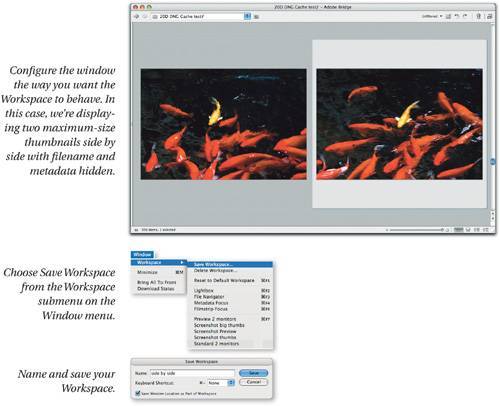 For those of you who have to know where all things get saved, Workspaces are stored in Users/username/Library/Application Support/Adobe/Bridge/Workspaces on Mac OS and in Documents and Settings\Username\Application Data\Adobe\Bridge\Workspaces on Windows. Tip: Bridge Navigation You can always navigate in Bridge with the mouse, but it's often more efficient to do so from the keyboard. Here's a list of most of our favorites. In the Folders panel, the up and down arrow keys move up and down one folder at a time. Adding the Command key moves up one level in the hierarchy. The right arrow key expands folders containing subfolders; the left arrow key collapses them. In the Metadata panel, Tab advances to the next editable field, Shift-Tab to the previous one, and Enter commits an entry. In the Keywords panel, the up and down arrows move up and down the keywords list. In the main window, the up, down, left, and right arrows move the selection to the next thumbnail in their respective directions. Adding Shift extends the selection to include the next thumbnail in that direction. (You can't, however, make discontiguous selections from the keyboardyou have to Command-click the thumbnails to add noncontiguous images to the selection.) Home selects the first thumbnail, and End selects the last one. Command-A selects all thumbnails, and Command-Shift-A deselects all thumbnails. Command-Option-L selects all labeled images, while Command-Option-Shift-L selects all unlabeled images. Last but not least, Command-Shift-I inverts the selection, deselecting the selected images and selecting the formerly unselected ones. |
EAN: N/A
Pages: 220
